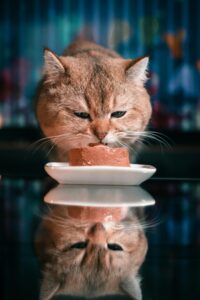Unlocking the Secrets of Cat Food Labels for Healthier Felines
At first glance, reading cat food labels might seem trivial, yet it is paramount in ensuring your cherished feline friend receives the nutritional balance essential for their health and vitality. These labels are much more than just packaging text; they serve as a vital guide to understanding the quality and ingredients of your cat’s diet. By immersing yourself in the details presented on these labels, you can make educated choices that significantly enhance your cat’s overall well-being and lifespan. Taking the time to learn about these labels can lead to a healthier, happier cat.
A key element of cat food labels is the specialized terminology employed. Phrases like “complete and balanced” indicate that the product meets the nutritional standards set forth by the Association of American Feed Control Officials (AAFCO). Understanding these terms places you in a better position to select foods that offer the essential nutrients your cat requires for thriving. This knowledge empowers you as a pet owner, allowing you to make deliberate choices that cater to your cat's unique dietary needs and health outcomes.
While examining cat food packaging, you will often see terms such as ‘natural’ or ‘organic’. These labels can be enticing for consumers, yet they carry distinct meanings and implications regarding quality. The term ‘natural’ usually suggests that there are no artificial flavors or colors present, but it does not necessarily imply superior quality. On the other hand, ‘organic’ refers to specific production methods that generally ensure higher safety and quality standards, making it a favorable option for health-conscious pet owners looking to provide the best for their furry companions.
The AAFCO plays a crucial role in establishing nutritional standards within the pet food industry. Their guidelines guarantee that products labeled as ‘complete and balanced’ meet specific nutritional criteria tailored to different life stages. For pet owners aiming to make informed decisions about their cat's diet and overall health, comprehending these labels is essential. By applying this knowledge, you can confidently select the most suitable food options that cater to your feline’s individual requirements, ensuring they thrive at every stage of life.
Having a solid grasp of the information presented on your cat’s food label can dramatically enhance your ability to make nutritious choices that support their health and well-being. The insights you gather will enable you to select high-quality food options that align with your cat's dietary needs, fostering a longer, healthier life filled with vitality.
 Understanding Cat Food Ingredients: Essential Insights for Pet Owners
Understanding Cat Food Ingredients: Essential Insights for Pet Owners
A vital component of mastering cat food labels is a thorough examination of the ingredients list. Ingredients are typically listed by their weight before cooking, meaning that the first few components on the list represent the primary constituents of the food. This hierarchy is essential, as it offers critical insights into what your cat is consuming daily and the overall quality of their diet.
As obligate carnivores, it is crucial that cat food prioritizes protein sources at the top of the ingredient list. Look for specific protein sources like chicken, beef, or salmon, rather than vague terms such as ‘meat meal’. This specificity indicates a higher quality and more nutritious diet that aligns with your cat's natural dietary preferences and requirements, thereby fostering their health and energy levels.
It is equally important to recognize and limit certain additives and fillers in your cat's diet. Ingredients like corn, soy, or wheat gluten may increase the food's volume but offer minimal nutritional benefits for cats. Instead, prioritize options that incorporate whole grains and vegetables, which can serve as healthier alternatives, contributing to a balanced and well-rounded diet that promotes overall health.
Be wary of artificial preservatives commonly found in pet foods, such as BHA, BHT, and ethoxyquin. Although these substances are often included to enhance shelf life, they may not be the healthiest options for your feline companion. Opt for foods that utilize natural preservatives like vitamin E (tocopherols) or vitamin C (ascorbyl palmitate) to maintain the integrity of their diet while ensuring their safety and health.
Should you encounter unfamiliar or lengthy ingredient names, take the initiative to research them. Being well-informed about what your cat consumes is the best way to ensure you are making choices that genuinely support their health and well-being, fostering a proactive approach to their dietary needs.
Evaluating Nutritional Content: Creating the Perfect Diet for Your Cat
Understanding the Guaranteed Analysis section of cat food labels is vital for gaining insights into the nutrient composition of the food. This section typically outlines the minimum or maximum percentages of crude protein, fat, fibre, and moisture. Achieving the right balance in these nutrients is crucial for maintaining your cat’s overall health and preventing nutritional deficiencies.
The protein content is perhaps the most significant consideration when selecting cat food. Cats require elevated levels of protein to flourish, so it’s essential to ensure that adequate amounts derive from animal sources, which provide the essential amino acids necessary for their well-being. Avoid foods that lean heavily on plant-based proteins, as these often lack the complete spectrum of nutrients that cats need for optimal health and vitality.
Carbohydrate content also plays a crucial role in your cat's diet. While some carbohydrates can be beneficial when included in moderation, they should not overshadow the primary ingredients, particularly for cats prone to weight gain. Aim for foods that emphasize higher protein and lower carbohydrate levels to support a healthy, balanced diet that meets your cat's specific energy requirements.
Essential nutrients, such as taurine, are critical for your cat's health. Taurine is vital for maintaining heart and eye health, and since cats cannot produce it independently, it is imperative to ensure your chosen food contains this essential component. Always verify the label to confirm that taurine is included, as it contributes significantly to your cat's overall health.
Be aware of potential allergic reactions in cats that may arise from specific food ingredients or dietary imbalances. Common allergens can vary, so it is essential to observe your cat closely for any unusual reactions. If necessary, consider exploring hypoallergenic food options specifically designed for sensitive cats, ensuring that their dietary needs are adequately met.
 Proven Strategies for Choosing the Best Cat Food for Your Beloved Companion
Proven Strategies for Choosing the Best Cat Food for Your Beloved Companion
Selecting the right food for your cat involves more than merely picking the product with the most eye-catching packaging. It’s about aligning the nutrition with your cat’s unique lifestyle and needs. When making your decision, consider critical factors such as your cat's age, activity level, and any specific health conditions they may have, ensuring that their diet is tailored to support their overall health.
Customizing your cat’s diet according to their lifestyle can significantly impact their health and energy levels. For instance, an active outdoor cat typically requires more calories and protein than a less active indoor cat. Being attentive to their daily activities can guide you in providing a diet that adequately supports their specific energy requirements and promotes optimal vitality.
Price does not always equate to quality; therefore, it is crucial not to be swayed by cost alone. Sometimes, you may find yourself paying a premium for branding rather than genuine nutritional benefits. Understanding what the ingredients and nutritional breakdown signify for your cat's health is far more important than the price tag, ensuring that you are investing in their well-being.
Remember that pet food brands often change their recipes, sometimes subtly, sometimes significantly. Staying informed about these alterations ensures that you are always aware of what is being served in your cat's bowl. Regularly checking for updates from brands can help you avoid unexpected dietary shifts that may adversely affect your cat's health and nutrition.
Lastly, consulting with your veterinarian can provide personalized insights tailored to your cat's specific health needs. A veterinarian can recommend appropriate foods that address dietary restrictions or health concerns, giving you peace of mind that your cat is receiving optimal nutrition for a happy, healthy life.
The Article : How To Interpret Your Cat’s Food Labels Appeared First On Unity Pets.
The Article Interpreting Cat Food Labels: A Quick Guide Was Found On https://limitsofstrategy.com

I really appreciate how you broke down the importance of cat food labels. It’s surprising how many pet owners skip over this crucial information. I’ve definitely had my share of trial and error when it comes to finding the right food for my cat. When I switched to a brand that honestly labeled its ingredients, I noticed a huge difference in her energy and coat health.
It’s interesting how a simple switch in food can lead to such noticeable changes in our pets. The importance of transparency in pet food ingredients can’t be overstated; it really makes a difference in our understanding of what we’re feeding them. I’ve also gone through the trial and error phase with my pets and have come to appreciate brands that are open about their ingredients.
You’ve raised a great point about the impact of food choices on our pets’ health and well-being. It’s fascinating how a small change in diet can lead to significant differences in their energy levels, coat condition, and even temperament. The more we know about what goes into their food, the better decisions we can make.
Your insights on the significance of cat food labels are spot on; I’ve often found that many pet owners overlook what really goes into their cats’ diets. I remember when I first encountered the term “complete and balanced” on a label. It led me down a path of research about AAFCO standards, which opened my eyes to the varied quality of pet foods available.
It’s great to hear you’ve dived into the world of pet food labels! The “complete and balanced” label can feel like a buzzword at first, but it really is a key part of ensuring our cats get the nutrition they need. AAFCO does a nice job setting those standards, but it’s still a jungle out there when it comes to different brands and formulations.